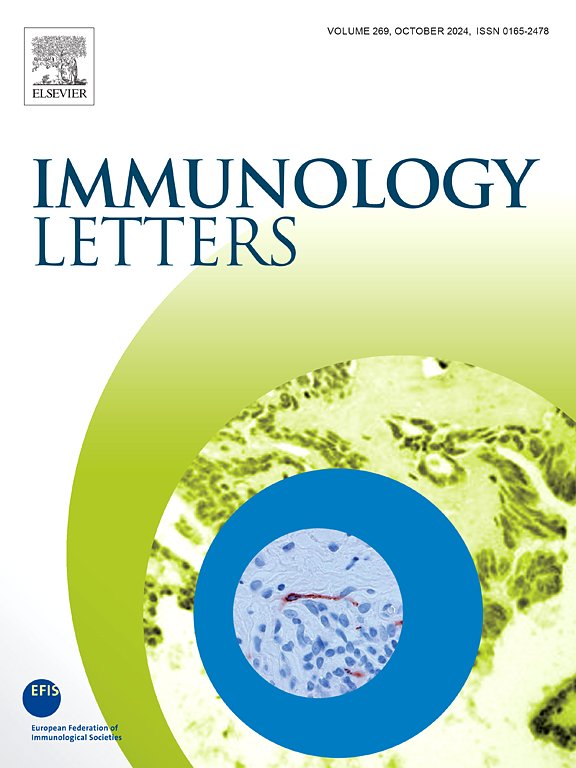Lenvatinib联合抗pd -1的免疫增强作用及其与TACE联合治疗不可切除肝细胞癌的原理
IF 2.8
4区 医学
Q3 IMMUNOLOGY
引用次数: 0
摘要
背景:尽管抗-PD-1和仑伐替尼联合治疗取得了令人鼓舞的临床疗效,但对其作用机制的深入研究仍然很少。此外,尽管临床上广泛采用全身抗PD-1或伦伐替尼治疗与局部经导管动脉化疗栓塞(TACE)联合治疗不可切除的HCC,但由于研究有限,不同联合方案的疗效并不确定:我们首先制作了小鼠HCC模型,以验证抗PD-1和仑伐替尼联合治疗的抗肿瘤效果。方法:我们首先制作了小鼠 HCC 模型,验证了抗 PD-1 和仑伐替尼联合疗法的增强抗肿瘤效果,然后利用单细胞质量细胞计数法(CyTOF)从表型上揭示了它们的作用机制。之后,我们进一步比较了TACE加仑伐替尼(即TACE-Len)双联疗法与TACE、仑伐替尼加抗PD-1(即TACE-Len-PD-1)三联疗法作为不可切除HCC转换疗法的有效性:结果:伦伐替尼和抗PD-1联合疗法不仅能提高全身CD4+、CD8+ T细胞和B细胞的比例,还能削弱由免疫抑制细胞(即MDSCs)和协同抑制介质(即PD-L1和LAG-3)产生的免疫耐受功能,从而产生活化的免疫图谱。同时,我们的研究还表明,与TACE-Len双疗法相比,TACE-Len-PD-1三联疗法能以强大的免疫特征对不可切除的HCC产生更好的临床反应:结论:我们的研究提供了抗PD-1和仑伐替尼联合治疗的微妙免疫图谱,并提供了TACE-仑-PD-1三联疗法比TACE-仑双联疗法能获得更好临床疗效的科学证据,有望为临床应用提供客观有效的证据。本文章由计算机程序翻译,如有差异,请以英文原文为准。
The immune-reinforcements of Lenvatinib plus anti-PD-1 and their rationale to unite with TACE for unresectable hepatocellular carcinoma treatment
Background
Despite encouraging clinical benefits have gained by anti-PD-1 and Lenvatinib combination, in-depth characterizations about the mechanisms of action remain poorly characterized. Furthermore, although the combination of systemic anti-PD-1 or Lenvatinib treatment and locoregional transcatheter arterial chemoembolization (TACE) is widely carried out to treat unresectable HCC in clinical, the efficacies of different combination regimens are uncertain due to limited researches.
Methods
We firstly generated murine HCC models to validate the enhanced anti-tumor effects of anti-PD-1 and Lenvatinib combination therapy. Then single cell mass cytometry (CyTOF) was employed to phenotypically reveal their mechanisms of action. After that, we further compared the effectiveness of TACE plus Lenvatinib (i.e., TACE-Len) dual therapy with TACE, Lenvatinib plus anti-PD-1 (i.e., TACE-Len-PD-1) triple therapy as conversion therapy for unresectable HCC.
Results
Lenvatinib and anti-PD-1 combination could generate activated immune profiles not only by increasing systemic CD4+, CD8+ T cells and B cells proportions, but also by weakening the immune-tolerance functions derived from both immunosuppressive cells (i.e., MDSCs) and co-inhibitory mediators (i.e., PD-L1 and LAG-3). Meanwhile, our study also suggested that TACE-Len-PD-1 triple therapy could achieve better clinical responses with powerful immune profiles for unresectable HCC compared to TACE-Len dual therapy.
Conclusions
Our study provided a delicate immune landscape of anti-PD-1and Lenvatinib combination, and we also offered scientific evidences that TACE-Len-PD-1 triple therapy could fulfill better clinical benefits than TACE-Len dual therapy, which is anticipated to provide objective and effective evidences for clinical use.
求助全文
通过发布文献求助,成功后即可免费获取论文全文。
去求助
来源期刊

Immunology letters
医学-免疫学
CiteScore
7.60
自引率
0.00%
发文量
86
审稿时长
44 days
期刊介绍:
Immunology Letters provides a vehicle for the speedy publication of experimental papers, (mini)Reviews and Letters to the Editor addressing all aspects of molecular and cellular immunology. The essential criteria for publication will be clarity, experimental soundness and novelty. Results contradictory to current accepted thinking or ideas divergent from actual dogmas will be considered for publication provided that they are based on solid experimental findings.
Preference will be given to papers of immediate importance to other investigators, either by their experimental data, new ideas or new methodology. Scientific correspondence to the Editor-in-Chief related to the published papers may also be accepted provided that they are short and scientifically relevant to the papers mentioned, in order to provide a continuing forum for discussion.
 求助内容:
求助内容: 应助结果提醒方式:
应助结果提醒方式:


